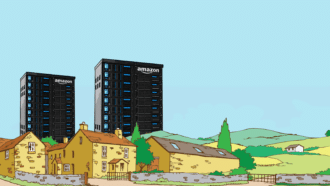New UK data centres could have a devastating impact on our environment, and our national water and power resources
Can you name your nearest data centre? Look for a warehouse – about 400,000 square feet across – crammed full of servers storing and processing data. It’s roasting hot, full of bank after bank of server farms gulping their way through huge amounts of power and water, without pause, every moment of every day.
Don’t worry if you haven’t heard about them before – because you’re about to start seeing them everywhere. The new government has quietly put building tonnes more of these new power and water guzzlers at the heart of their plans for the economy.
In Rachel Reeves’s interview on the Today programme on the morning of her speech at Labour party conference, the Chancellor made a list of priorities for “getting Britain building”. After housing, “the data centres” was top of the pile.
Megabucks American investment firm Blackstone has just announced it will build the biggest data centre in Europe in Northumberland at the cost of £10bn. That came fast on the heels of Amazon Web Services’ announcement a few days before of a UK data centre construction programme worth £8bn.
Meanwhile, government is busy removing all obstacles to new construction – including anyone who may not want a power guzzler springing up next door. The government has announced plans to bypass local authorities’ planning rules by designating data centres as Nationally Significant Infrastructure Projects (NSIPs).
Last month, the government laid the groundwork for this by designating data centres as critical national infrastructure (CNI) – usually things like hospitals, airports and military bases. The addition of data centres is the first major update to the CNI list in a decade.
Should the government designate data centres as NSIPs as well, it would take the final say about building them away from councils and into the hands of the Secretary of State.
Foxglove and more than 1,500 of our supporters wrote in to the government’s consultation on making this change to the law, laying out our concerns about the effect on our national energy and water resources, our environment and our local democracy. You can read Foxglove co-executive director Martha Dark’s submission here.
But this plan has been in the works for a while. New Secretary of State for Science and Technology, Peter Kyle, met with Amazon executives just before the election, with the topic of how to dodge local planning permission for data centres “a key concern raised”.
Data centres are huge consumers of both power and water.
Before the AWS and Blackstone plans to build new data centres were announced, National Grid had already predicted power used by data centres in the UK will increase six-fold in the next decade.
Indeed, in some parts of the world, data centres’ power demands have resulted in states actually scaling up fossil fuel production and generation – and we already have more data centres than anywhere else in Western Europe. That spells bad news for the UK’s green energy transition plan.
The FT has reported on the sack of salt we need to apply to Amazon’s claims of carbon neutrality in the £8bn’s worth of data centres that AWS is set to build.
If the government would like a close-up view of what data centres can do to our national grid – and our energy bills – they need only glance across the Irish Sea.
In Ireland, data centres use more power than every urban household in the country combined. In the next three years, it’s estimated that data centres will account for around a third of all energy produced in Ireland. You’d imagine the Irish might have alternative plans for an entire third of their generated power.
And energy bills reflect that strain. Irish electricity prices were the third highest in the EU last year, an eye-watering 48% about average. That’s not a coincidence.
Data centres are also gluttons for fresh water, requiring billions of litres to cool the endless racks of power-hungry servers. Yet the poor state of our water supply has rarely been out of the headlines this year, with the notorious Thames Water potentially only months from folding and being taken over by the government.
Finally, it’s not clear new data centres are actually needed for the internet to grow and improve. According to a team of equity research analysts at Barclays, the additional data centre capacity produced by projects already under way would be enough to power the existing web, plus 12,000 new applications with the user base and input demands of ChatGPT.
So in short, the plan to massively ramp up data centre construction in the UK:
- poses serious problems for our already-strained water and power infrastructure;
- threatens our transition to a green and sustainable economy;
- may not actually be the investment needed to grow and improve our online world.
It doesn’t have to be this way. The Big Tech companies building these data centres are some of the richest companies on the planet. The government could make this enormous expansion conditional on their investment in real green energy projects – ensuring they give more than they take – to our power and water grids.
Foxglove is probing the legality of these plans and will say more about our future work in this space soon. Hit the button below to get the news when it’s out.

